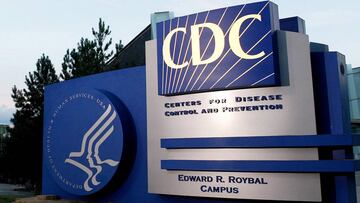Coronavirus: how have CDC guidelines changed about airborne transmission?
The Centers for Disease Control and Prevention changed its official Covid-19 guidelines on Friday, and then quickly retracted them. What happened?

A U-turn in the guidelines
Until now, the Centers for Disease Control and Prevention (CDC) said that Covid-19 was thought to spread mainly between people in close contact (about 6 feet) and "through respiratory droplets produced when an infected person coughs, sneezes or talks."
However on Friday 18 September, updated guidance on its website claimed that the virus can commonly spread "through respiratory droplets or small particles, such as those in aerosols" which are produced even when a person breathes. "Airborne viruses, including COVID-19, are among the most contagious and easily spread."
However, only a few days later, the CDC retracted this update. As of Monday 21 September it has explained that the update was in fact an error: "A draft version of proposed changes to these recommendations was posted in error to the agency's official website. CDC is currently updating its recommendations regarding airborne transmission of SARS-CoV-2 (the virus that causes COVID-19). Once this process has been completed, the update language will be posted".
So why all the hot air, and why does it matter if Covid-19 is airborne?
The CDC abruptly reverted to its previous guidance about how coronavirus is transmitted, removing language about airborne transmission it had posted just days earlierhttps://t.co/jchsx2Ti6e
— CNN Breaking News (@cnnbrk) September 21, 2020
What does ‘airborne’ mean?
The World Health Organisation (WHO) defines airborne infection as “inhalation of an infectious dose of virus from a suspended cloud of small dried droplets…that remain infectious when suspended in air over long distances and time.” In other words, tiny particles of the virus remain in the air after an infected person has been talking or breathing (ie. not coughing and sneezing) so that the air all around them could infect others.
This means that airborne viruses are far more easily spread than those that aren’t. The Ebola virus, for example, which killed over 11,300 people in five West African countries (Liberia, Guinea, Sierra Leone, Nigeria and Mali) as well as the US between 2014 and 2016, had an extremely high death rate; on average 50% compared to Covid-19 which is estimated at 3.4% globally.
However Ebola could only be spread through contact with infected bodily fluids; blood, faeces, vomit, semen and in extreme cases, even tears. Furthermore, to infect a healthy person the infected bodily fluid then needed to come into contact with a mucus membrane (for example the inside of the mouth, nose or eye) or a cut in the skin.
Why is the guidance important to me?
If the virus is indeed airborne, it could travel far further than 6 feet. This would mean that the current advice on hand washing and social distancing may be insufficient to prevent the spread of the virus, especially in crowded indoor spaces, making the use of masks in public even more important, even potentially changing the guidance on social distancing to further than 6 feet.
So is the virus airborne and what should I do?
Although the CDC has now retracted the original advice that Covid-19 could be even more infectious than originally thought, there is in fact mounting evidence that it could travel further than 6 feet via airborne droplets.
In April, a scientific panel led by Dr Harvey Fineberg, chairman of a committee with the National Academy of Sciences, presented a letter to the White House claiming that “while the current [coronavirus] specific research is limited, the results of available studies are consistent with aerosolization of virus from normal breathing”.
Then in July 239 scientists backed a letter that urged public health organisations to take more seriously the possibility that the novel coronavirus could be spread through more than just close person-to-person contact.
“There is significant potential for inhalation exposure to viruses in microscopic respiratory droplets (microdroplets) at short to medium distances (up to several meters, or room scale), and we are advocating for the use of preventive measures to mitigate this route of airborne transmission”.
The United States does not currently have a national mask mandate, but a patchwork of rules and laws across the country means 77% of Americans wear a mask when in public, according to YouGov’s coronavirus public monitor.
For the time being, the CDC guidelines remain as follows:
- Maintain good social distance (about 6 feet or 2 arms’ length).
- Wash your hands often with soap and water. If soap and water are not available, use a hand sanitizer that contains at least 60% alcohol.
Related stories
- Routinely clean and disinfect frequently touched surfaces.
- Cover your mouth and nose with a mask when around others.


